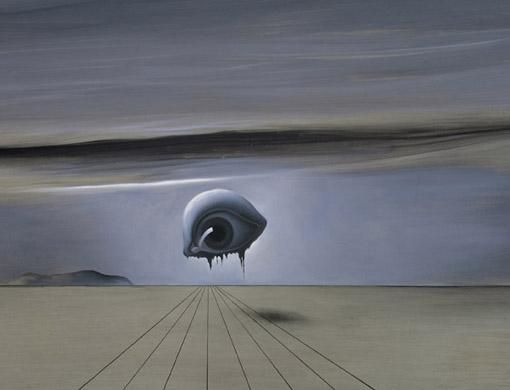When ants start marching out of the palm of your hand, it is cause for alarm, even if it is only a dream.
Eyeballs floating by your head? Safe to say you are probably watching a film spawned by the twisted mind of Salvador Dalí.
Everyone's favourite surrealist is haunting New York's Museum of Modern Art this summer, in a thrilling exhibition called Dalí: Painting and Film.
The biggest shiver comes right at the top of the show, where Un Chien Andalou (An Andalusian Dog), Dalí's legendary 1929 collaboration with Spanish director Luis Buñuel, is playing to throat-clutching effect.
This short, silent film features not only those ants but the famous close-up of a man (actually Buñuel himself) slicing through a woman's eye with a razor blade.
More people may have heard about this scene than have actually viewed it, but one of the great things about this show, the first major Dalí exhibition to reach New York in 60 years, is that it couches a multitude of pleasures between the shocks.
In just six galleries at MoMA (and a programme of half a dozen related films in a museum screening room), Dalí offers copious and fascinating evidence of the artist's many unrealised film projects, as well as a first-hand experience of true Surrealism.
On the walls surrounding both Un Chien Andalou and L'Age d'or, a sound film of thwarted and entirely perverse desire that Dalí and Buñuel made in 1930, are pieces of their correspondence, including painted and drawn studies for the films.
With them are also a number of paintings made during the period when Dalí created the melting clocks, monstrous trysts and barren landscapes for which he is best known.
But who knew about the film he wanted to make with Harpo Marx, or the animated feature for Walt Disney? (Those who have never seen Dalí's signature Lobster Telephone of 1936 can worship at its altar here.)
A 1927 sketch of the ant-infested hand is actually quite beautiful, while images such as that of a hairy armpit turning into a sea urchin should keep even the most blasé viewer riveted.
Born in Spain in 1904, Dalí grew up with the invention of cinema, a medium with a distinct ability to visualise our worst fears and use them in the service of entertainment.
Artists such as Man Ray and Fernand Leger were experimenting with film around the same time, but only the Dalí/Buñuel collaborations took hold of the popular imagination.
In fact, they were the only two film projects Dalí would ever complete on his own.
His only other successful collaboration was with Alfred Hitchcock, who commissioned Dalí to design Gregory Peck's hallucinatory dream sequence in 1945's Spellbound.
That crucial scene is also playing here, accompanied by an actual painted backdrop used in the film and several studies for the shower of floating eyeballs whose scissoring is as close as Dalí would ever come to the triumph of Un Chien Andalou.
Otherwise, Dalí's film ideas never even made it to the cutting room, much less its floor. The images he created for the planned film with Harpo, Giraffes on Horseback Salad, are all that survive of that conceit.
The Japanese attack on Pearl Harbor in 1941 derailed a film by Fritz Lang for which Dalí had designed a brothel-slaughterhouse sequence.
Destino, a six-minute animated love story Dalí made for Disney, apparently was too provocative for the creator of Mickey Mouse. (A 2003 version, based on Dalí's storyboard, is on view here with his sketches.)
The show ends with Dalí himself on film, twitching his waxed moustache in one of Andy Warhol's best “Screen Tests'' and trashing a copy of a Mondrian painting in a nutty 1960 video with photographer Philippe Halsman.
Dalí's enthusiasm for the moving image never waned; before he died in 1989 he was transitioning into television.
No doubt he would be uploading digital films to YouTube were he still with us, scaring the psychic pants off yet another generation primed to discover him now.
Dalí: Painting and Film continues through September 15 at the Museum of Modern Art, New York. For details, log on to www.moma.org.
Drawn to films
Bringing together more than 130 paintings, drawings, scenarios and films by Salvador Dalí (1904 to 1989), this show explores the role cinema played in the artist's work.
Both an inspiration and an outlet for experimentation, film was Dalí's passion, and cinematic vision became a model for his work.
Collaborations between Dalí and legendary filmmakers are displayed alongside his paintings and other works, illuminating the ways in which ideas, iconography and pictorial strategies are shared and transformed across mediums.
Among the provocative works on display are “Un Chien Andalou'', which features the notorious sequence of an eye being slit by a razor; “L'Age d'Or'', one of the landmarks of Surrealist film; projects undertaken in Hollywood with Alfred Hitchcock and Walt Disney; and such important paintings as “The First Days of Spring'' and “Illumined Pleasures''.
Along with the show, a series of screenings in the MoMA theatres presents the classic and avant-garde motion pictures Dalí treasured, films on which he collaborated, and examples of his legacy in cinema.
-Information courtesy: www.moma.org












